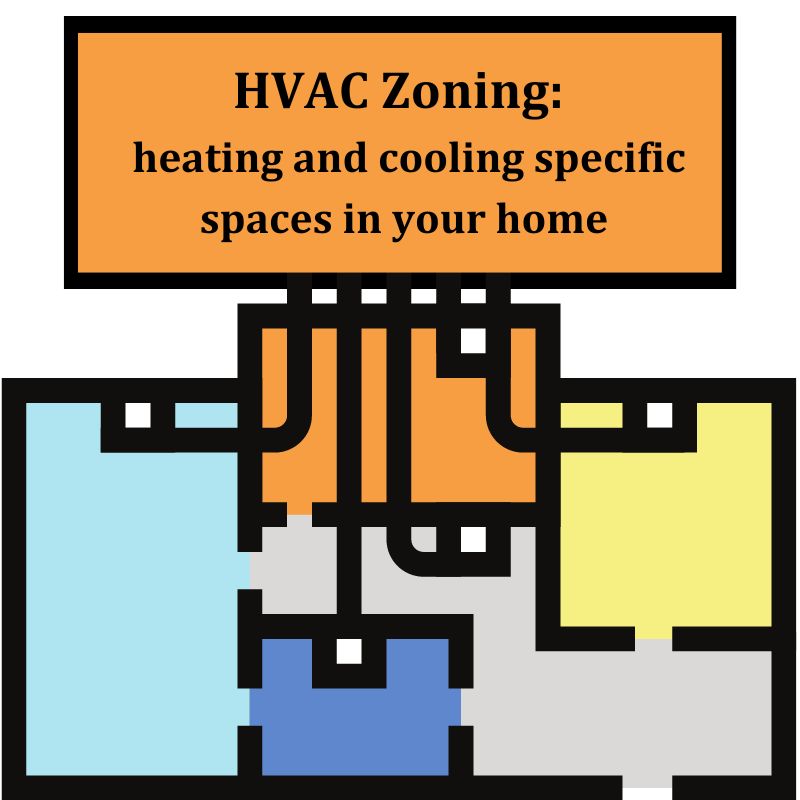Manual zoning has been around for as long as people have been heating and cooling their homes and spaces. Many homeowners do their best to save money and avoid heating and cooling certain areas by closing doors or register vents for rooms that are not being used.
However, this is a short term solution that doesn’t always work and can impact the comfort and enjoyment of our home. It can also put extra strain on your system, rather than offer it relief. So, what can be done? Well, one way to address this is to add a zoning system to the existing HVAC system in your home.
What Is HVAC Zoning?
In simple terms, HVAC zoning refers to heating and cooling specific spaces in your home versus the entire home. This allows you to set different temperatures for different areas of your home at the same time.
Using a window air conditioner unit in the room you sleep in, or only using the radiator or space heater of the room you are occupying (as opposed to the whole house) are examples of zoned heating and cooling. But we aim to introduce ways to work this method into your current HVAC setup.

Here in Tennessee, newer and larger homes tend to be built with multiple systems, while older homes were built to have only one system. These older two-story homes are a prime example of why HVAC zoning is ideal. In a typical two-story home with one HVAC system, you can end up with a warm or cool space downstairs, while the upstairs is experiencing the opposite.
Single story homes that have sprawling floor plans can also experience temperature discrepancies due to the distance that certain rooms and spaces are from the thermostat and how many windows they have.
The great news is that zones can be added to your existing system!
How Do I Add Zones to Standard HVAC Equipment?
If you have found that the HVAC system in your home is not living up to your desired temperature control needs, then adding a zoning system may be right for you. As a homeowner, you want to feel comfortable and enjoy the climate in all areas of your home, which is why a zoned system may be ideal if you find yourself with a home similar to those described above.
One way to address this is using dampers in your ducts to add zones. We can work with you to figure out the best way to incorporate these into your current HVAC system to ensure zone heating is efficiently implemented – without putting more wear and tear on your system in the process.
We also encourage you to ask about our mini-split ductless systems, which are great for heating and cooling only specific areas of your home. These are great for remodels or additions.
What Are the Pros and Cons of HVAC Zoning?
While HVAC zoning can give you the power to create climate zones and heat or cool specific rooms, it does come with its own set of pros and cons. It is important to do your own research and speak to a professional, like the crew here at Pettit Heating & Cooling, to see if HVAC zoning is right for you and your home.
Pros:
- Less wasted energy from heating rooms that aren’t being used
- Reduced maintenance costs, as the wear on the unit should be less
- No need to fight over temperature settings – zones allow for variability in temperature preferences
Cons:
- Higher upfront costs for upgrading an existing system
- Initial installation can be invasive due to the additional components that may need to be added
- Maintenance challenges can arise due to the addition of more components to your system
Is My Home a Good Candidate for a Zoning System?
A zoning system may be beneficial to you of your home has:
- Rooms that are seldom used
- Two or more stories
- Raised ceilings in a few rooms
- Chronically cold or hot rooms
- More windows in one area
- Rambling, single story floor plans
- Occupants with different temperature preferences.
- Adequate ductwork and equipment to add an HVAC zoning system to your home
- New additions or rooms added on
Reach Out Today
Adding an HVAC zoning system to your home can provide an energy efficient way to enhance the comfort and enjoyment of your home for you and your family. Call the professional at Pettit Heating & Cooling today to discuss how to add zoning options to your existing home, or to look at a new, zoned HVAC replacement unit.
Reach out at 615-654-0814 or you can start your appointment with us online today.

Recent Comments